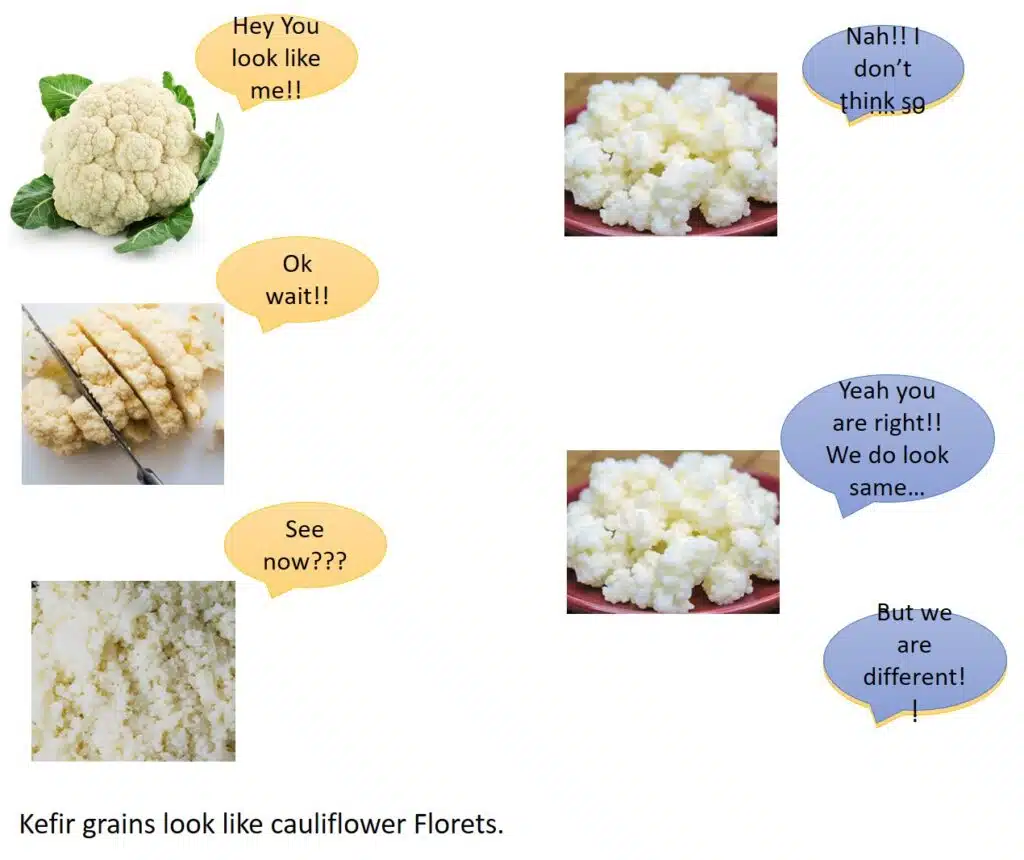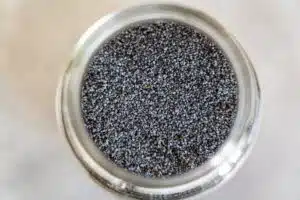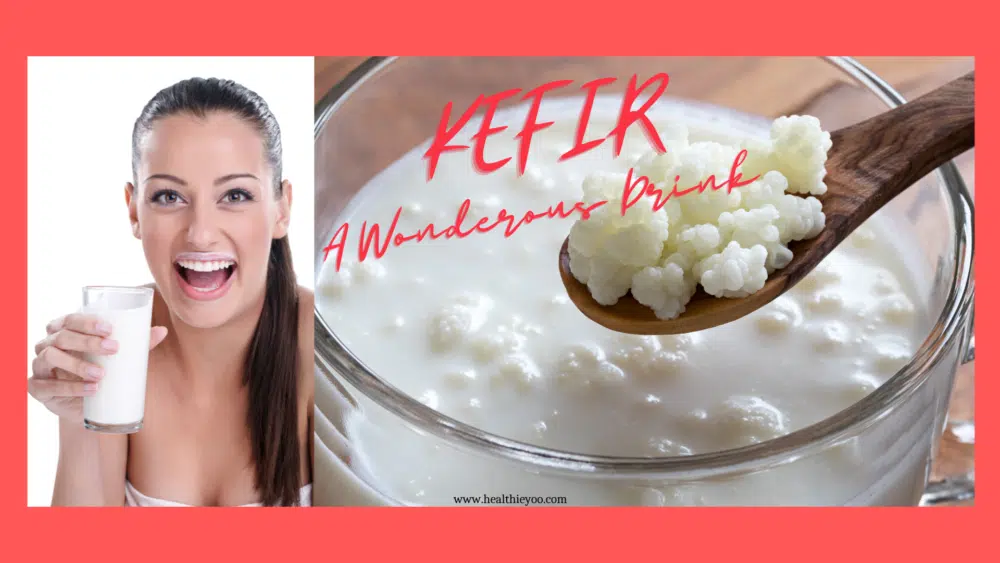What is Kefir? Or Milk Kefir?
Kefir is a type of fermented milk drink that is made from kefir grains. The milk kefir drink is widely produced and consumed in Russia, Europe, and the United States. Here is the difference between kefir and yogurt, kefir vs yogurt, the nutrition facts and health benefits of milk kefir grains, the variants of kefir, the water kefir, and how to make kefir at home.
What are Kefir Grains?
Kefir grains are not grains in the real sense. Kefir grains are creamy-white colored, floret shaped, and gelatinous substances that comprise a matrix of protein and polysaccharides.
Kefiran is the main polysaccharide found in the kefir grain matrix. Kefiran is a heteropolysaccharide composed of glucose and galactose.
This matrix contains a unique composition of probiotics – bacteria and yeasts. These microorganisms feed on milk (usually cow, goat, or sheep milk) that is used to culture these grains.
The composition of the microorganisms in the kefir grains varies according to their culturing conditions.

Kefir vs Yogurt – What is the difference between Kefir And Yogurt?
Kefir and yogurt both are milk-based probiotics but they differ in their composition of microorganisms and culturing methods.
While yogurt is composed of mainly Lactobacillus delbrueckii bulgaricus and Streptococcus thermophilus bacteria, the microbial composition of kefir is comparatively enormous (around 60 species) and varies depending on the origin of kefir grains and culturing conditions. But the key species in kefir grains are Lactobacillus kefiranofaciens and Saccharomyces turicensis. In addition, acetic acid bacteria such as A. aceti and A. rasens, yeasts such as Candida kefir and S. cerevisiae, etc., and other Lactobacillus species are present in variable proportions.
A wide range of microbial metabolites is produced due to the complex interaction between all the microbes present in kefir. These metabolites give kefir its characteristic flavor.
Kefir tastes tangier as compared to yogurt.
In terms of culture conditions, yogurt requires a temperature of around 40℃ for around 4-12 hrs while kefir is cultured at ambient temperature (18℃ to 24℃) for 24 hrs.
Milk Kefir Grains – Nutrition facts
Milk Kefir is one of the richest sources of probiotics and hence is a boon for gut health.
According to USDA calculations1, 100 grams serving of low-fat kefir (kefir milk/ kefir grains) contains:
Water | 89.7 grams | |
Energy | 43 kcal | ~1.72% of average daily requirement |
Protein | 3.79 grams | ~7.58% of average daily requirement |
Lipid | 1.02 grams | ~1.05% of average daily requirement |
Carbohydrate | 4.77 grams | ~1.90% of average daily requirement |
Calcium | 130 mg | ~13% of average daily requirement |
Phosphorus | 105 mg | ~2.6% of average daily requirement |
Potassium | 164 mg | ~4% of average daily requirement |
Sodium | 40 mg | ~2.7% of average daily requirement |
Magnesium | 12 mg | ~3.4% of average daily requirement |
Zinc | 0.46 mg | ~4.6% of average daily requirement |
Iron | 0.04 mg | ~4% of average daily requirement |
Vitamin B5 | 0.385 mg | ~7.7% of average daily requirement |
Vitamin B3 | 0.15 mg | ~1% of average daily requirement |
Vitamin B2 | 0.135 mg | ~9% of average daily requirement |
Vitamin B6 | 0.058 mg | ~4% of average daily requirement |
Vitamin B1 | 0.03 mg | ~2.5% of average daily requirement |
Vitamin E | 0.02 mg | ~0.1% of average daily requirement |
Vitamin C | 0.2 mg | ~0.25% of average daily requirement |
Choline | 15.2 mg | ~3.3% of average daily requirement |
In addition, Kefir milk also contains many bioactive compounds, including organic acids and peptides that contribute to its health benefits2.
Kefir Health Benefits (Milk Kefir Or Kefir Grains)
Kefir, whether grains or milk kefir, is rich in many bioactive metabolites which are known to have a positive effect on health in general.
Traditionally, kefir is believed to help in recovery from many clinical conditions like allergies, gastrointestinal problems, hypertension, even as part of cancer therapy, etc. but the scientific basis for the same is still not enough3.
Being a powerful probiotic drink, milk kefir –
1. Milk Kefir helps people with lactose intolerance to enjoy the nutritional benefits of milk:
Lactose intolerance is a condition where a person is not able to digest enough lactose (milk sugar) due to either absence or decreased activity of lactase enzyme in the body. As a result, the consumption of milk or any milk product leads to abdominal discomfort. During kefir production, microbes ferment most of the lactose present in milk while retaining the majority of other nutritional benefits of milk.
2. Milk Kefir aids digestion:
Milk kefir made from Kefir grains aids in digestion. The metabolites produced by microbes also help in improving digestion.
3. Kefir lower cholesterol levels:
Some evidence suggests that milk kefir prepared from Kefir grains helps lowering cholesterol levels.
4. Kefir milk protects against pathogens:
How to make Kefir?
Kefir can be very easily made at home using the traditional method. All you need is kefir grains, milk, and some kitchen equipment.
How to make kefir? Just inoculate 4 cups of milk with around one tablespoonful of kefir grains and let it ferment in a clean environment for a period between 18–24 hours at 20–25°C. The fermentation should be carried out in a non-metal container.
It is also recommended to lightly agitate the container in order to ensure well mixing of kefir grains and milk. The container can be covered with a piece of filter cloth or paper towels.
At the end of the fermentation process, sieve out the kefir grains. Milk kefir is ready for consumption.
After fermentation, sieved-out kefir grains can be stored for 1-7 days in fresh milk at 4°C or can be immediately used for a new round of fermentation.
Availability of Kefir grains!
So, now you know how to make kefir but from where to obtain kefir grains? Kefir grains are easily available in grocery stores in the health food section or on popular online markets like eBay, Amazon, etc. as dried culture.
Alternatively, wet kefir grains can be obtained from someone who regularly makes kefir at home (There is a high chance that they have an active culture in their fridge, you just need to ask for it).
Is the microorganism composition the same in initial kefir grains and the grains that are strained out after fermentation?
The answer is usually NO.
It depends a lot on the fermentation conditions like temperature, time, level of agitation, the initial mass of kefir grains used as seed culture, and the type of milk used for fermentation. But nevertheless, the kefir grains remain active for a long time. In fact, if carefully handled, the grains may retain their activity for years.
Is it important to use non-metal containers only for preparing kefir?
YES!
Metal usually interferes with the fermentation process and often harms or weakens the microorganisms present in the culture. So, it is advised to use only non-metal equipment while preparing kefir. Glass is preferred to make kefir as it is easily available in the kitchen. Wood, clay pot, plastic, etc. are other alternatives.

Can I go wrong with kefir production?
Unfortunately, YES!
If hygienic conditions are not followed, or metals interfere with the kefir production or too much seed culture is used, or the fermentation is left to stand for very long or at a higher temperature, things can go wrong. Any of these things can lead to an unpleasant taste or aroma. If the growth of microbes is too rapid or too much, it can produce a vinegar-like aroma due to excessive acetic acid production.
But with little care and practice, it is very easy to make perfect kefir. We just need to optimize the steps according to our taste.
Industrial production of kefir
In industries, kefir production can occur by two methods. Russian method and pure culture method.
Russian method is more like the traditional method, where the culture starts from grains, and then percolate is used for further fermentations.
In the pure culture method, the milk is inoculated with pure cultures isolated from kefir grains. The mixture is first maintained at 8–10 °C for up to 24 hours. This step is optional and is called the maturation phase. The introduction of this phase allows yeast present in the cultures to grow and it gives a specific flavour to the final product.
After that, the kefir production is carried out with the same principle.
Variants of Kefir
Although the traditional kefir is plain milk kefir, the wonderous drink has evolved over time with multiple variants. Obviously, these variants will have a different flavour and nutrient profile than traditional kefir, but they are worth giving a try.
Kefir tastes best with full cream milk, however, toned or low-fat milk can also be used to inoculate the kefir grains.
In addition, dairy-free versions are also preferred by some, where in place of milk, other nutrient sources are used. For example, coconut milk, soya milk, etc.
What is water kefir? Water kefir vs Milk kefir
When in place of milk, sweet water is used to make kefir, it is known as water kefir.
In the case of water kefir, the microorganisms in the kefir grains feed on and ferment another form of sugar in place of lactose (milk sugar). Another form of sugar can be sucrose, fructose, or glucose in water kefir. For example, one can use coconut water or some fruit drink with or without added sugar.
The microbes use most of the sugar from the water to produce lactic acid (So your drink is a low-calorie drink!!! Do not worry about that sugar, it’s for microbes not for you).
The resulting liquid tastes like sparkling water with the base flavour.
But the grains used to make water kefir are different than those used to make milk kefir. These grains are more translucent than milk kefir grains and contain fewer probiotic microbes than milk kefir.
You can also pair your kefir with baked cookies, ice cream, fruits like berries, mango, apples, nuts like cashew, almonds, or make kefir smoothies, etc.
Many variants are already available in the market as commercial beverages which may have added preservatives for increasing their shelf life. However, these commercial beverages may not provide the same therapeutic and probiotic health benefits as provided by traditional kefir.

So, it is a very good idea to procure these wonderous grains and start your kefir routine. Also, next time you visit a supermarket, go and grab your kefir to get an idea of its taste.
Maybe you were thinking of a good start-up for a very long time…….????
References
- FoodData Central. https://fdc.nal.usda.gov/fdc-app.html#/food-details/170904/nutrients.
- Leite, A. M. de O. et al. Microbiological, technological and therapeutic properties of kefir: a natural probiotic beverage. Brazilian J. Microbiol. 44, 341 (2013).
- Farag, M. A., Jomaa, S. A., El-wahed, A. A. & El-seedi, H. R. The Many Faces of Kefir Fermented Dairy Products: Quality Characteristics, Flavour Chemistry, Nutritional Value, Health Benefits, and Safety. Nutrients 12, (2020).

Heena Pahwa
Related Posts

How To Have A Happy Gut For A Happy You!
Food And Mood Connection and the happiness gut connection – Did you know that happy foods lead to happy moods via a happy gut? Mental

Symptoms of SIBO vs IBS, hydrogen vs methane SIBO symptoms and Hydrogen sulfide SIBO
SIBO – the real cause of your bloating and how to get rid of it? SIBO stands for Small Intestinal Bacterial Overgrowth and is one

Women And Gut Health: Its Impact On Periods Health
Gut health, it’s this sexy term that is thrown around in our culture today but what does this term truly mean? Well, I’m going to

Synbiotic, Prebiotic, Probiotic – Take Care Of Your Gut
What is Gut Microbiota? Why do we have Gut Microbiota? What is Dysbiosis? What are dysbiosis symptoms? What causes dysbiosis? How to maintain a healthy

Fatty Acids, Triacylglycerol, Cholesterol – The Wonders of Fats!
Are fats healthy? Check out the wonders of fats – the fatty acids such as MUFA and PUFA, the triacylglycerol, and the cholesterol. As a

Benefits of Chia Seeds (Salvia hispanica) in Daily Food
Chia Seeds (Salvia hispanica) Fats in Chia Seeds Protein & Fibre in Chia Seeds Vitamins & Minerals in Chia Seeds Health Benefits of Chia Seeds

